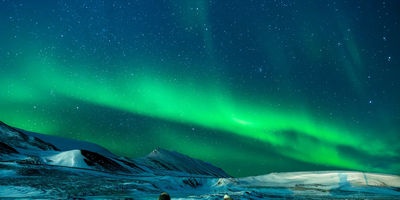|
 The auroras are as beautiful as they are mysterious. The enthusiastic verbosity with which they talk about their beauty is replaced by unintelligible “probably”, “presumably”, “it seems to us”, as soon as it comes to the origin and properties of this amazing phenomenon. The auroras are as beautiful as they are mysterious. The enthusiastic verbosity with which they talk about their beauty is replaced by unintelligible “probably”, “presumably”, “it seems to us”, as soon as it comes to the origin and properties of this amazing phenomenon.
It is known that auroras "shine" in the ionosphere (and hence the entire complex of helio-geophysical processes), that their lower boundary usually runs about a hundred kilometers above the Earth, the upper one - sometimes a thousand kilometers or more. It is believed that the "culprit" of the aurora is the Sun with its ubiquitous corpuscles. They think that it is precisely because of the lights that the ionosphere is so capricious and so annoyingly affects the wonderful polar radio operators, when they strain their ears with all their might and hear a continuous crackling and hum in the air.
Less known are some curious and far from yet explained features of auroras. Well, let's say, the fact that the aurora borealis appear more often over those areas where magnetic anomalies have been discovered or ores are being developed (in any case, geologists not only admire this phenomenon, but also look closely: what is below, “under the aurora? ... Or else: polar geophysicists drew attention to the fact that the shape of the auroras, as it were, repeats, copies the outlines of the shores of the Arctic Ocean. Entire fragments of a geographical map of the Arctic (and in the south - Antarctica) suddenly appear in the sky, and, of course, this is not an accidental coincidence: too often and too many observers have noted a similar picture. Explanations? There are many of them, but there is no single, complete explanation yet. And one more last thing: it seems that it has been established that the aurora, cold, God knows at what height the sparkling multicolored auroras ... heat the atmosphere of the polar regions. Not very noticeably, of course, but they definitely heat up - the corpuscles, interacting with the atmosphere, give it their energy.
To summarize briefly, auroras undoubtedly serve as the key to understanding the physics of plasma, magnetohydrodynamics, atomic and molecular processes. So, in any case, geophysicists believe.
And this phenomenon of nature is well known to any of us. Sometimes (for example, during a thunderstorm) we, as if recollecting ourselves, remember its existence, but in everyday life we do not realize its significance, and this is at least ingratitude. Life itself on the planet would be impossible if there were no ozone in the world.
 Ultraviolet rays of the sun "set fire" the atmosphere, irradiate oxygen molecules, make them decay into atoms. Then follows a purely chemical process of "docking" of an atom with a molecule that has not yet had time to disintegrate. The result is a triatomic ozone molecule. A newly born child becomes an implacable enemy of its parent - the Sun! Ozone turns into a kind of filter that does not allow the omnipotent star to destroy life on Earth. It delays the death-carrying stream of ultraviolet radiation, which is ready to turn our planet into a charred desert, to cause radiation sickness in all, without exception, terrestrial creatures of a terrible force. It is no coincidence that one of the most cannibalistic military projects is connected precisely with this natural phenomenon: with the help of some chemical substance, sent to the height of the ozone layer, "pierce" this layer, make "windows" in it, and make them with great precision - directly over the major cities of the enemy. Deprived of powerful protection, the city will instantly be burnt by the Sun, so warm, so gentle ... Ultraviolet rays of the sun "set fire" the atmosphere, irradiate oxygen molecules, make them decay into atoms. Then follows a purely chemical process of "docking" of an atom with a molecule that has not yet had time to disintegrate. The result is a triatomic ozone molecule. A newly born child becomes an implacable enemy of its parent - the Sun! Ozone turns into a kind of filter that does not allow the omnipotent star to destroy life on Earth. It delays the death-carrying stream of ultraviolet radiation, which is ready to turn our planet into a charred desert, to cause radiation sickness in all, without exception, terrestrial creatures of a terrible force. It is no coincidence that one of the most cannibalistic military projects is connected precisely with this natural phenomenon: with the help of some chemical substance, sent to the height of the ozone layer, "pierce" this layer, make "windows" in it, and make them with great precision - directly over the major cities of the enemy. Deprived of powerful protection, the city will instantly be burnt by the Sun, so warm, so gentle ...
The thickness of the ozonosphere (one more sphere!) Is several tens of kilometers, the maximum concentration of atmospheric ozone is at an altitude of twenty to forty kilometers.If we mentally cut out a vertical column from the atmosphere and bring the ozone contained in it to normal pressure and temperature, then the thickness of the ozone layer will be equal to only ... three millimeters. Here is what a shaky film our whole life flows under!
In which I must once again emphasize that the Arctic ozonosphere is a special thing, it is "thicker" than over other regions of the world. Some relationships are outlined between the amount of ozone and the intensity of auroras, between the size of the ozone layer and the temperature and air pressure in the surface atmosphere. The tight geophysical knot becomes tighter and tighter with the emergence of each new branch of observations, but thus it becomes easier and easier to unravel this scientific tangle.
Z. Kanevsky - Ice and Fate
Read now
All recipes
|
 The auroras are as beautiful as they are mysterious. The enthusiastic verbosity with which they talk about their beauty is replaced by unintelligible “probably”, “presumably”, “it seems to us”, as soon as it comes to the origin and properties of this amazing phenomenon.
The auroras are as beautiful as they are mysterious. The enthusiastic verbosity with which they talk about their beauty is replaced by unintelligible “probably”, “presumably”, “it seems to us”, as soon as it comes to the origin and properties of this amazing phenomenon. Ultraviolet rays of the sun "set fire" the atmosphere, irradiate oxygen molecules, make them decay into atoms. Then follows a purely chemical process of "docking" of an atom with a molecule that has not yet had time to disintegrate. The result is a triatomic ozone molecule. A newly born child becomes an implacable enemy of its parent - the Sun! Ozone turns into a kind of filter that does not allow the omnipotent star to destroy life on Earth. It delays the death-carrying stream of ultraviolet radiation, which is ready to turn our planet into a charred desert, to cause radiation sickness in all, without exception, terrestrial creatures of a terrible force. It is no coincidence that one of the most cannibalistic military projects is connected precisely with this natural phenomenon: with the help of some chemical substance, sent to the height of the ozone layer, "pierce" this layer, make "windows" in it, and make them with great precision - directly over the major cities of the enemy. Deprived of powerful protection, the city will instantly be burnt by the Sun, so warm, so gentle ...
Ultraviolet rays of the sun "set fire" the atmosphere, irradiate oxygen molecules, make them decay into atoms. Then follows a purely chemical process of "docking" of an atom with a molecule that has not yet had time to disintegrate. The result is a triatomic ozone molecule. A newly born child becomes an implacable enemy of its parent - the Sun! Ozone turns into a kind of filter that does not allow the omnipotent star to destroy life on Earth. It delays the death-carrying stream of ultraviolet radiation, which is ready to turn our planet into a charred desert, to cause radiation sickness in all, without exception, terrestrial creatures of a terrible force. It is no coincidence that one of the most cannibalistic military projects is connected precisely with this natural phenomenon: with the help of some chemical substance, sent to the height of the ozone layer, "pierce" this layer, make "windows" in it, and make them with great precision - directly over the major cities of the enemy. Deprived of powerful protection, the city will instantly be burnt by the Sun, so warm, so gentle ...





